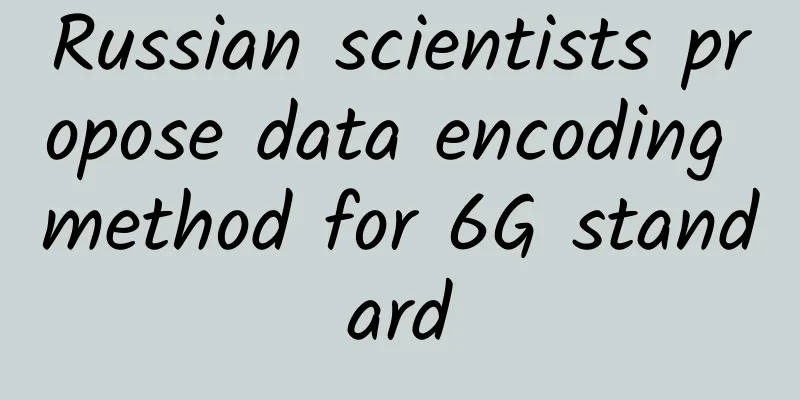Russian scientists propose data encoding method for 6G standard

|
Researchers around the world are working on ways to transmit data in the terahertz (THz) range, which would make it possible to send and receive information much faster than today's technology. But encoding data in the THz range is much more difficult than in the gigahertz (GHz) range used by current 5G technology. Terahertz waves are between the end of the microwave band and the beginning of the infrared band. Terahertz is an electromagnetic wave with a frequency of 0.3 to 3 THz. It is a new band with many unique advantages. It is the frequency between the high-frequency edge of the millimeter wave band of electromagnetic radiation (300 GHz) and the low-frequency edge of the far-infrared spectrum band (3000 GHz). The corresponding wavelength of radiation in this band ranges from 1mm to 0.1mm (or 100μm), so it is also called the "submillimeter band". Scientists from ITMO University in Russia have demonstrated the possibility of modifying terahertz pulses for use in data transmission. Telecommunications companies in developed economies are beginning to adopt the new 5G standard, which will deliver faster wireless data speeds, while scientists are already working on its successor. “We are working on 6G technology, which will increase data transmission speeds by 100 to 1,000 times, but implementing 6G requires us to switch to the terahertz range,” said Igor Oparin, a staff member at the Femtosecond Optics and Femtosecond Technologies Laboratory at ITMO University in Russia. Now, a technology for transmitting multiple data channels simultaneously over a single physical channel has been successfully implemented in the infrared (IR) range. The technology is based on the interaction between two broadband infrared pulses, with a bandwidth measured in tens of nanometers. In the terahertz range, the bandwidth of such pulses would be much larger. But scientists and engineers will need to find solutions to a number of key problems. One of them is ensuring that the two pulses interfere. "In the terahertz range, pulses tend to contain a small number of field oscillations. Literally, one or two per pulse, and they are so short that they look like thin peaks on the graph," Oparin said. "It is quite challenging to achieve this kind of interference between pulses because they hardly overlap." (a) Spectrum, (b) temporal structure and linear frequency modulation of simulated linear frequency modulated THz pulses. (c) Quasi-discrete spectrum and (d) two linear frequency modulated A team of ITMO scientists has suggested stretching the pulses so that their duration is several times longer, but still measured in picoseconds. In this case, the frequencies within one pulse will not appear simultaneously, but will follow one another. In scientific terms, this is called linear frequency modulation. However, this poses another challenge: while linear frequency modulation technology is already quite developed in the infrared range, its application in the terahertz range is still understudied. Igor Oparin, a staff member of the ITMO University Laboratory of Femtosecond Optics and Femtosecond Technologies "We have turned to a technique used in the microwave range," Oparin said. "With metallic waveguides, these waveguides tend to have high dispersion, which means that different transmitted frequencies propagate at different speeds there. But in the microwave range, these waveguides are used in single mode. In other words, the field is distributed in one configuration, a specific, narrow frequency band, and usually one wavelength. We took a similar waveguide with dimensions suitable for the terahertz range and passed a broadband signal through it, causing it to propagate in a different configuration. As a result, the duration of the pulse became longer, from 2 picoseconds to around 7 picoseconds, which is 3.5 times longer. This was our solution." By using a waveguide, the researchers have been able to increase the length of the pulse to the theoretically necessary duration. This makes it possible to achieve interference between two linear frequency modulations. (a) Linear frequency modulation of THz pulses and its approximate index, (b) quasi-discrete spectrum, and (c) temporal structure of pulse trains. "The great thing about this linear frequency modulation is that it shows the dependence between the structure of the pulse in time and the spectrum," Oparin said. "So we have the temporal form, or simply put, the field oscillations in time, and the spectral form, which represents these oscillations in the frequency domain. Let's say we have three peaks, three substructures in the temporal form, and three corresponding substructures in the spectral form. By removing part of the spectral form using a special filter, we can get flashes in the temporal form, and vice versa. This could be the basis for encoding data in the terahertz band." The research results were published in the journal Scientific Reports. |
<<: How do LoRa and LoRaWAN help build smart cities?
>>: Do you know which city has the fastest Wi-Fi speed in the world?
Recommend
DesiVPS launches NVMe hard drive series Los Angeles VPS starting from $20 per year
DesiVPS sent a new email saying that it has launc...
The 2017 International Anti-Malware Testing Standards Organization Annual Meeting was successfully held in Beijing
On December 5-6, the 2017 Annual Meeting of the I...
Yecao Cloud: Hong Kong special cloud server annual payment starts from 138 yuan, independent server monthly payment starts from 399 yuan
Yecaoyun, a Chinese VPS host, has released a new ...
Riverbed officially releases SaaS solutions for on- and off-cloud
The hottest word in the technology field in 2016 ...
The router is not to blame for the slow WiFi connection. Look at the receiving end.
The Year of the Rooster has arrived! Good luck to...
Research on 5G promoting industrial information transformation and upgrading
Three years after 5G was put into commercial use,...
Sharktech: $59/month 1Gbps unlimited traffic server, E3-1270v2/16GB/500G SSD/Los Angeles high defense
Sharktech's two promotional machines this mon...
China successfully launches the world's first quantum satellite "Micius"
At 01:40 on August 16, China successfully launche...
Yu Yang, CEO of Farmland Manager: Farmland services are delivered at one stop, and small farms also need great wisdom
[51CTO.com original article] If you see a drone f...
Interview Frequent: Talk about everything about HTTP caching
Speed, speed, and speed. If a website wants to pr...
Technical Tips | Alibaba Cloud's Practical Exploration of Building Lakehouse Based on Hudi
1. Data Lake and Lakehouse At the 2021 Developer ...
Network security knowledge: View the user license agreement
It is very necessary to understand the user licen...
10 common data center operation and maintenance errors that can cause panic
Some common sense mistakes can reduce the data ce...
Wi-Fi 6 forces basic network equipment to upgrade
Wi-Fi 6 (802.11ax) is here, and more and more wir...
How to use SSL/TLS in Node.js
This article is reprinted from the WeChat public ...









